Summary
Health examinations for lead poisoning were made on 62 family members from 15 families of homes carrying on lead work, such as quench-hardening in a molten lead bath and type-printing, as work at home. The most interesting findings concern the occurrence of cases with an unduly high lead absorption among children, but not among adult family members other than home lead-workers. The home environments of the children with an unduly high lead absorption represented contamination with housedust high in lead contents. The ingestion of the contaminated housedust by hand-to-mouth is probably responsible for the excessive lead exposure of the affected children. The results of the present study suggest that contanimation of housedust with lead due to home lead-work constitutes a possible hazardous source of lead exposure for children.
Similar content being viewed by others
References
Baker EL, Folland DS, Taylor TA, Frank M, Peterson W, Lovejoy G, Cox D, Housworth J, Landrigan PJ (1977) Lead poisoning in children of lead workers. Home contamination with industrial dust. N Engl J Med 296:260–261
Center for Disease Control (1975) Increased lead absorption and lead poisoning in young children. A statement by the Center for Disease Control. J Pediatr 87:824–830
Charney E, Sayre J, Coulter M (1980) Increased lead absorption in inner city children: where does the lead come? Pediatrics 65:226–231
Katagiri Y, Okamoto Y, Toriumi H, Kawai M (1979) Urinary lead, coproporphyrin, and δ-aminolevulinic acid levels in three-year-old children and their mothers [in Japanese]. Jpn J Hyg 34:146
King BG (1971) Maximum daily intake of lead without excessive body lead-burden in children. Am J Dis Child 122:337–340
Kubasik NP, Volosin MT (1973) A simplified determination of urinary cadmium, lead, and thallium, with use of carbon rod atomization and atomic absorption spectrophotometry. Clin Chem 19:954–958
Lepow ML, Bruckman L, Gillette M, Markowitz S, Robino R, Kapish J (1975) Investigations into sources of lead in the environment of urban children. Environ Res 10:415–426
Needleman H, Scanlon J (1973) Getting the lead out. N Engl J Med 288:466–467
Sayre JW, Charney E, Vostal J, Pless IB (1974) House and hand dust as a potential source of childhood lead exposure. Am J Dis Child 127:167–170
Tomokuni K, Ogata M (1972) Simple method for determination of urinary δ-aminolevulinic acid as an index of lead exposure. Clin Chem 18:1534–1536
Volosin MT, Kubasik NP, Sinn HE (1975) Use of the carbon rod atomizer for analysis of lead in blood: Three methods compared. Clin Chem 21:1986–1987
Votal JJ, Taves E, Sayre JW, Charney E (1974) Lead analysis of house dust: a method for the detection of another source of lead exposure in inner city children. Environ Health Perspect 7:91–97
WHO Task Group (1977) Environmental health criteria 3, Lead. WHO, Geneva
Author information
Authors and Affiliations
Rights and permissions
About this article
Cite this article
Kawai, M., Toriumi, H., Katagiri, Y. et al. Home lead-work as a potential source of lead exposure for children. Int. Arch Occup Environ Heath 53, 37–46 (1983). https://doi.org/10.1007/BF00406175
Received:
Accepted:
Issue Date:
DOI: https://doi.org/10.1007/BF00406175




